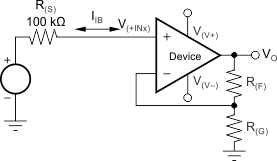ZHCSI77F June 2009 – May 2018 OPA2354A-Q1 , OPA354A-Q1 , OPA4354-Q1
PRODUCTION DATA.
8.2.2 High-Impedance Sensor Interface
Many sensors have high source impedances that may range up to 10 MΩ, or even higher. The output signal of sensors often must be amplified or otherwise conditioned by an amplifier. The input bias current of this amplifier can load the sensor output and cause a voltage drop across the source resistance, as shown in Figure 40, where (V(+INx) = VS – I(BIAS) × R(S)). The last term, I(BIAS) × R(S), shows the voltage drop across R(S). To prevent errors introduced to the system as a result of this voltage, use an op amp with low input bias current and high-impedance sensors. This low current keeps the error contribution by I(BIAS) × R(S) less than the input voltage noise of the amplifier, so that the amplifier does not become the dominant noise factor. The OPAx354-Q1 family of devices series of op amps feature low input bias current (typically 200 fA), and are therefore designed for such applications.
 Figure 40. Noise as a Result of I(BIAS)
Figure 40. Noise as a Result of I(BIAS)